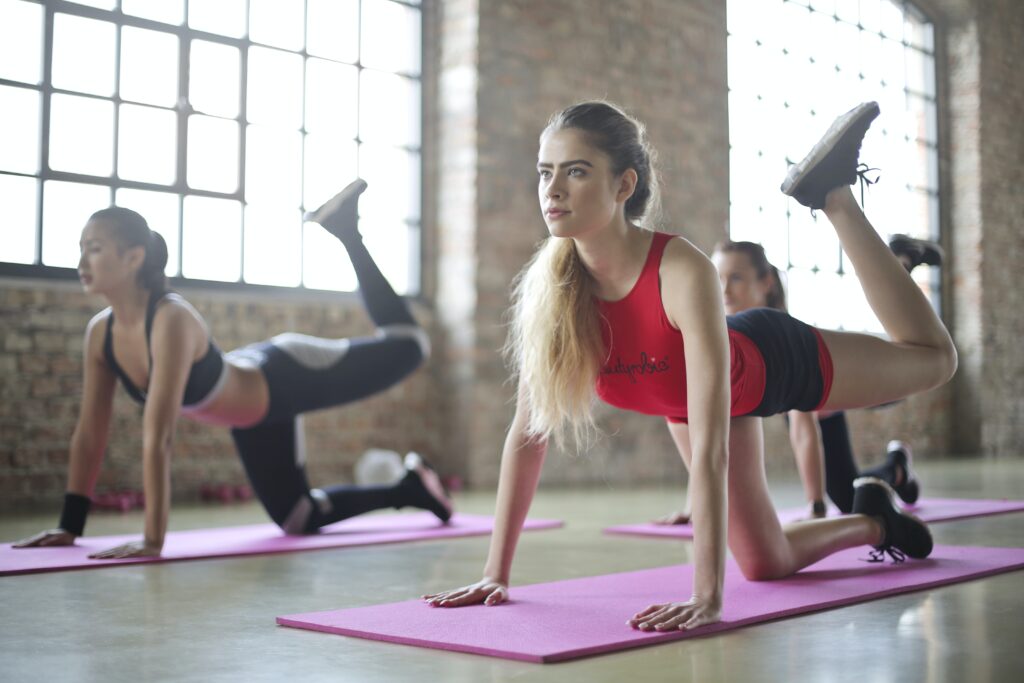If you’re looking to jumpstart your fitness journey but don’t know where to begin, “How To Get In Shape: A Beginner’s Guide To Exercise And Diet” is here to help. This comprehensive article serves as your go-to resource for all things fitness, offering expert advice and practical tips that will guide you towards achieving your health and wellness goals. Whether you’re a complete newbie to exercise or just in need of a refresher, this beginner’s guide will provide you with the tools and knowledge to kickstart your transformation. So, get ready to take charge of your fitness and embark on a journey towards a healthier, fitter you!

Exercise
Choosing the Right Type of Exercise
When it comes to choosing the right type of exercise, it’s important to consider your interests, abilities, and goals. There are so many options out there, from running and cycling to swimming and weightlifting. The key is to find something that you enjoy and that fits your lifestyle. If you love being outdoors, you might consider activities like hiking or gardening. If you prefer a group setting, try joining a fitness class or team sport. By choosing an exercise that you genuinely enjoy, you will be more likely to stick with it in the long run.
Setting Fitness Goals
Before you can create an exercise plan, it’s important to set fitness goals. Your goals will give you something to work towards and help to keep you motivated. When setting your fitness goals, it’s important to be realistic and specific. Instead of saying “I want to get in shape,” try setting a goal like “I want to be able to run a 5k in under 30 minutes.” By setting specific and attainable goals, you will be able to track your progress and see real results.
Creating an Exercise Plan
Once you have set your fitness goals, it’s time to create an exercise plan. This plan will outline the types of exercises you will do, how often you will do them, and for how long. It’s important to start slowly and gradually increase the intensity and duration of your workouts. If you are new to exercise, start with just a few days a week and gradually add in more days as you build strength and endurance.
Creating a Balanced Workout Routine
A balanced workout routine should include a mix of cardiovascular exercises, strength training, and flexibility and stretching. Cardiovascular exercises, such as running or cycling, help to improve your heart health and increase your endurance. Strength training, such as lifting weights or doing bodyweight exercises, helps to build muscle and increase your overall strength. Flexibility and stretching exercises, such as yoga or Pilates, help to improve your flexibility and prevent injuries. By including all three types of exercises in your routine, you will be able to achieve a well-rounded workout.
Cardiovascular Exercises
Cardiovascular exercises, also known as cardio or aerobic exercise, are exercises that increase your heart rate and breathing rate. These exercises help to improve your cardiovascular health, burn calories, and increase your endurance. Some examples of cardiovascular exercises include running, cycling, swimming, and dancing. When choosing a cardiovascular exercise, it’s important to find something that you enjoy and that suits your fitness level. Start with a moderate-intensity exercise and gradually increase the intensity as you become more fit.
Strength Training
Strength training exercises are designed to strengthen and tone your muscles. These exercises can be done with free weights, weight machines, or using your bodyweight. Strength training helps to increase your muscle mass, which in turn increases your metabolism and helps you burn more calories. It is important to work all major muscle groups in your strength training routine, including your arms, chest, back, legs, and core. Start with lighter weights and gradually increase the weight as you become stronger.
Flexibility and Stretching
Flexibility and stretching exercises are often overlooked but are essential for maintaining a healthy and functional body. These exercises help to improve your range of motion, prevent injuries, and improve your posture. Some examples of flexibility and stretching exercises include yoga, Pilates, and static stretching. When stretching, it’s important to warm up your muscles first with a light cardio exercise and then hold each stretch for at least 20-30 seconds. Remember to breathe deeply and never bounce while stretching.
Importance of Rest and Recovery
Rest and recovery are just as important as exercise itself. It’s during rest periods that your body repairs and rebuilds muscle tissue, allowing you to become stronger and more fit. Overtraining and not giving your body enough time to recover can lead to injuries, fatigue, and a decrease in performance. Make sure to schedule rest days into your exercise plan and listen to your body. If you are feeling sore or fatigued, it’s okay to take a day off, or engage in light activities like stretching or walking.
Tracking Progress
Tracking your progress is an important part of achieving your fitness goals. By keeping track of your workouts, you can see how far you have come and stay motivated. There are many ways to track your progress, including using a fitness app, a journal, or simply keeping track of your workouts in a calendar. Record important metrics such as the duration and intensity of your workouts, the weights used in strength training, and any improvements in your endurance or flexibility. Celebrate your progress along the way to keep yourself motivated and inspired.
Staying Motivated
Staying motivated can be a challenge, especially when faced with setbacks or plateaus. It’s important to remember why you started and to focus on the positive impact that exercise has on your physical and mental well-being. Here are some tips to help you stay motivated:
- Set realistic and attainable goals.
- Find an exercise buddy or join a fitness community for support and accountability.
- Mix up your routine to keep things interesting.
- Reward yourself for reaching milestones.
- Track your progress and celebrate each achievement.
- Focus on the benefits of exercise, such as improved energy levels and stress relief.
- Remember that every workout counts, even if it’s just a short walk or stretching session.
By incorporating these tips into your fitness journey, you will be able to stay motivated and make exercise a lifelong habit.
Diet
Understanding Nutrition
Understanding nutrition is a crucial part of maintaining a healthy diet. It’s important to know the basics of macronutrients (carbohydrates, proteins, and fats) and micronutrients (vitamins and minerals), as well as their role in the body. A balanced diet should include a variety of foods from different food groups to ensure that you are getting all the necessary nutrients. Eating a balanced diet can help to improve your energy levels, support optimal bodily functions, and prevent diseases.
Setting Dietary Goals
Just like setting fitness goals, setting dietary goals is essential for maintaining a healthy diet. Your dietary goals should be realistic and based on your individual needs and preferences. For example, you might set a goal to eat at least five servings of fruits and vegetables every day or to limit your intake of sugary beverages. By setting specific goals, you can track your progress and make adjustments to your diet as needed.
Creating a Meal Plan
Creating a meal plan can help you stay on track with your dietary goals. Start by planning your meals and snacks for the week, taking into consideration your schedule and your individual nutritional needs. Aim to include a balance of protein, carbohydrates, and healthy fats in each meal. Plan for healthy snacks to have on hand for when hunger strikes. Preparing meals in advance or batch cooking can also save time and make it easier to stick to your meal plan.
Importance of Hydration
Staying hydrated is extremely important for overall health and well-being. Water is essential for transporting nutrients, regulating body temperature, and removing waste from the body. It’s recommended to drink at least eight cups (64 ounces) of water per day. However, individual hydration needs may vary depending on factors such as activity level and climate. It’s important to listen to your body and drink when you are thirsty. If you struggle with plain water, you can infuse it with fruits or herbs to add flavor.
Nutrient Timing
In addition to what you eat, when you eat can also impact your overall health and fitness goals. Nutrient timing refers to the timing of meals and snacks to maximize the body’s ability to use and store nutrients. For example, consuming protein-rich foods after a workout can help with muscle recovery and growth. It’s important to eat regular meals and snacks throughout the day to maintain steady energy levels and prevent overeating.
Balancing Macronutrients
Balancing macronutrients, such as carbohydrates, proteins, and fats, is important for maintaining a healthy diet. Each macronutrient plays a unique role in the body and has different energy values. Carbohydrates provide energy, proteins help with muscle repair and growth, and fats support brain function and hormone production. It’s important to include a balance of all three macronutrients in your diet, taking into consideration your individual goals and dietary needs.
Choosing Healthy Foods
Choosing healthy foods is essential for a balanced diet. Opt for whole, unprocessed foods whenever possible, as they tend to be higher in nutrients and lower in added sugars and unhealthy fats. Include a variety of fruits, vegetables, whole grains, lean proteins, and healthy fats in your diet. Avoid or limit the consumption of highly processed foods, sugary snacks, and sugary beverages. Focus on eating mindfully and enjoying the taste and texture of your food.
Meal Prepping
Meal prepping can be a game-changer when it comes to sticking to a healthy diet. By preparing meals and snacks in advance, you can save time and ensure that you always have nutritious options on hand. Dedicate a specific day or time during the week to plan and prepare meals. Consider using containers to portion out meals ahead of time, making it easier to grab a healthy option when you’re on the go. Experiment with different recipes and flavors to keep your meals interesting and enjoyable.
Understanding Portion Control
Understanding portion control is important for maintaining a healthy weight and preventing overeating. It’s easy to underestimate portion sizes, especially when dining out or eating packaged foods. Using measuring cups, a food scale, or visual cues can help you gauge appropriate serving sizes. It’s also helpful to listen to your body’s hunger and fullness cues and stop eating when you feel satisfied, rather than overly full.
Avoiding Fad Diets
Fad diets are often tempting in their promises of quick weight loss or other health benefits. However, these diets are typically restrictive, unsustainable, and may lack essential nutrients. Instead of following a fad diet, focus on adopting a balanced, nutritious eating pattern that you can maintain for the long term. Remember that a healthy diet is not about restriction or deprivation, but about nourishing your body with wholesome foods.
In conclusion, getting in shape requires a combination of regular exercise and a balanced diet. By choosing the right type of exercise, setting fitness goals, and creating a well-rounded workout routine, you can improve your physical fitness and overall health. Similarly, understanding nutrition, setting dietary goals, and making informed food choices can help you maintain a healthy and sustainable diet. Remember to stay motivated, track your progress, and make adjustments to your exercise and diet plans as needed. With dedication and consistency, you can achieve your fitness goals and live a healthier, happier life.


